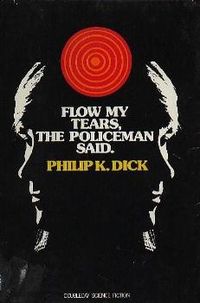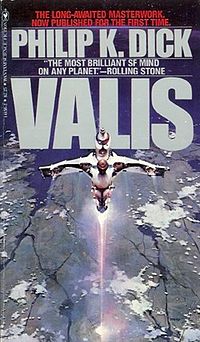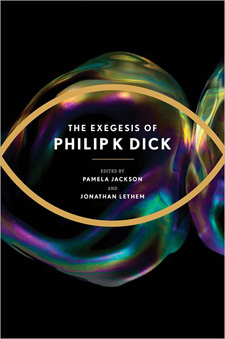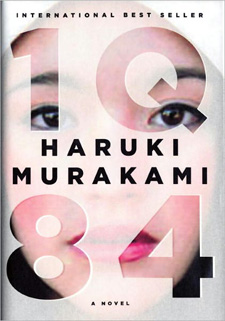There’s a scene relatively early in Haruki Murakami’s 1Q84 where Aomame, one of the novel’s two central characters, walks into the sunroom of her wealthy patron, who she finds “seated in her reading chair and listening to John Dowland’s instrumental piece ‘Lachrimae,'” which “was one of her favorite pieces of music,” we’re told: “Aomame had heard it many times and knew the melody.”
As I suggested to the mainstream readership at Shelf Awareness when I reviewed 1Q84 there last week, I’m just about convinced that this is an Easter egg for Philip K. Dick fans, obliquely referencing Flow My Tears, the Policeman Said—and I’m not just talking about the fact that “Flow My Tears” is a version of “Lachrimae” with lyrics. The thematic overlap between the two novels is so significant that to me it’s not a question of whether Murakami has read Dick, but when. And, as we’ll see, Flow isn’t the only point of resonance.
Before we start, though, I should warn you that (a) I may be telling you more about 1Q84 than you want to hear if you’re planning to read it later or haven’t made it all the way through yet, and (b) I’ve spent most of the last month reading the new abridged edition of The Exegesis of Philip K. Dick at home and 1Q84 on the subway, so my head has been in a really, really interesting place lately.
In the novel’s opening scenes, Aomame leaves her taxi in the middle of a traffic jam on an elevated Tokyo expressway and climbs down the staircase of an emergency exit to the streets below. Very soon afterwards, she observes small details—the cut of a policeman’s uniform, the type of pistol in his holster—that eventually lead her to speculate that she has somehow slipped into a different reality. It’s the spring of 1984, so she decides to call this new timeline 1Q84 (“kyu” is 9 in Japanese). She’s still sorting out exactly how much history has changed when she notices an even more profound alteration: a second moon in the sky, “somewhat lopsided, and greenish,” hanging next to the usual one.
This doesn’t happen as a single narrative throughline. In alternating chapters, we learn about Tengo, a writer who’s been asked by an editor to read Air Chrysalis, a novella by Eriko Fukada, a 17-year-old girl using the pen name Fuka-Eri. “The writing is incredibly bad,” the editor says. “It’s ungrammatical, and in some places you have no idea what she’s saying.” And yet, Tengo counters, “the story itself has real power: it draws you in… After you work your way through the thing, with all its faults, it leaves a real impression—it gets to you in some strange, inexplicable way that may be a little disturbing.” That’s just the reaction the editor is looking for; he persuades Tengo to polish Fuka-Eri’s prose so they can submit Air Chrysalis for a literary prize. So he gets to work rewriting the story, which may or may not be based on something that happened to Fuka-Eri, and we get a few tantalizing details here and there: It’s about a little girl in an isolated commune, who encounters mysterious beings who call themselves the Little People, and (later in the story) a second moon appears in the sky.
At this stage of 1Q84, we don’t know what the new satellite in Air Chrysalis looks like, but we do know that Tengo’s editor wanted him to expand upon his original terse description: “When you introduce things that most readers have never seen before into a piece of fiction,” he advises, “you have to describe them with as much precision and in as much detail as possible.” Much later, when Aomame finally gets around to reading Air Chrysalis, she’ll discover that the second moon in the story looks just like the one in her sky, “like a slightly shriveled green pea.”
(Oh, hey, now might be a good time to mention that Aomame is not a typical Japanese name; on the second page of the novel, Murakami explains that she’s been kidded about it all her life, because it’s the word for “green peas.”)
During the novel’s climactic centerpiece, Aomame confronts the leader of the commune Fuka-Eri escaped from as a child. Most people can’t see the green moon, but he can; it’s the marker that signifies 1984 has been replaced by 1Q84. The Little People are real, he explains, and they have come to this world with a purpose that “surpasses our understanding and our definitions.” By collaborating on Air Chrysalis, though, Tengo and Fuka-Eri essentially created a counterforce to the Little People, a force so powerful that it drew Aomame into 1Q84 for reasons I’m not going to discuss because I don’t want to reveal everything in this essay. Suffice to say that she realizes “I am in the story that Tengo set in motion.”
 This may be a good time to talk about Flow My Tears, the Policeman Said—a story about Jason Taverner, a television celebrity who wakes up in a world that seems like the one he’s used to, except that nobody recognizes or remembers him anymore. It is eventually revealed that this is the result of an experimental drug affecting the user’s capacity to perceive time and space. “The brain can no longer tell which objects exist and which are only latent, unspatial possibilities,” a coroner explains to Felix Buckman, the high-ranking police official who listens to a recording of John Dowland’s “Lachrimae” in his office. Essentially, the brain picks one of the trillions of possible realities and perceives it until the drug wears off; Taverner was pulled into a reality created when Buckman’s sister dosed herself with the drug. (“She was very involved with Taverner as a wish-fulfillment performer, evidently,” Buckman’s assistant says, “and had run a fantasy number in her head for some time about knowing him as an actual person.”)
This may be a good time to talk about Flow My Tears, the Policeman Said—a story about Jason Taverner, a television celebrity who wakes up in a world that seems like the one he’s used to, except that nobody recognizes or remembers him anymore. It is eventually revealed that this is the result of an experimental drug affecting the user’s capacity to perceive time and space. “The brain can no longer tell which objects exist and which are only latent, unspatial possibilities,” a coroner explains to Felix Buckman, the high-ranking police official who listens to a recording of John Dowland’s “Lachrimae” in his office. Essentially, the brain picks one of the trillions of possible realities and perceives it until the drug wears off; Taverner was pulled into a reality created when Buckman’s sister dosed herself with the drug. (“She was very involved with Taverner as a wish-fulfillment performer, evidently,” Buckman’s assistant says, “and had run a fantasy number in her head for some time about knowing him as an actual person.”)
Let’s go back for a second to the coroner’s explanation about our brains, and “the instinct to stabilize reality in such a fashion that sequences can be ordered in terms of before-and-after—that would be time—and, more importantly, space-occupying, as with a three-dimensional object as compared to, say, a drawing of that object.” Now let’s return to 1Q84, and a conversation between Tengo and Fuka-Eri where he tells her that time has no form, “but since we can’t picture something without form in our minds, for the sake of convenience we understand it as a straight line.”
“Maybe time is nothing at all like a straight line,” Tengo continues. “Perhaps it’s shaped like a twisted doughnut. But for tens of thousands of years, people have probably been seeing time as a straight line that continues on forever… So as an experiential model, it’s probably correct.”
 Philip K. Dick was fascinated (or obsessed) with the ideas that time wasn’t really a straight line, and that there might be another reality other than the one we perceive—especially after his visionary experiences in early 1974, which he spent the rest of his life attempting to explain. The Exegesis ran to thousands of pages of meticulously detailed theories about holographic realities imposed on us by “the Empire” and the underground network of revolutionaries who fought to liberate humanity from those illusions. (Dick incorporated several of these ideas into the novel VALIS, including the proposition that “against the Empire is posed the living information, the plasmate or the physician, which we know as the Holy Spirit or Christ discorporate,” and that the living information will return to “kill the Empire by phagocytosis.” Stripped of the technical jargon: If the Empire is contaminating the universe, the living information “surrounds the toxic metal particle… and begins to destroy it.”
Philip K. Dick was fascinated (or obsessed) with the ideas that time wasn’t really a straight line, and that there might be another reality other than the one we perceive—especially after his visionary experiences in early 1974, which he spent the rest of his life attempting to explain. The Exegesis ran to thousands of pages of meticulously detailed theories about holographic realities imposed on us by “the Empire” and the underground network of revolutionaries who fought to liberate humanity from those illusions. (Dick incorporated several of these ideas into the novel VALIS, including the proposition that “against the Empire is posed the living information, the plasmate or the physician, which we know as the Holy Spirit or Christ discorporate,” and that the living information will return to “kill the Empire by phagocytosis.” Stripped of the technical jargon: If the Empire is contaminating the universe, the living information “surrounds the toxic metal particle… and begins to destroy it.”
Here’s how the Leader describes Air Chrysalis: Tengo and Fuka-Eri “invented an antibody to a virus. If we take the actions of the Little People to be a virus, Tengo and Eriko have created and spread the antibody to the virus.” Air Chrysalis, a fictional book for which—after several teasing glimpses—Murakami provides an extensive summary in 1Q84, has a counterpart in Valis, a fictional film within VALIS which Dick will also summarize at length and which includes significant details from the visions that the novel’s fictional version of Dick has been experiencing.
 In the Exegesis, Dick took the idea even further, suggesting that a scene at the end of Flow My Tears… was exactly this kind of living information. It was, he proposed, a glimpse of the real world, which made itself visible to us—here in the illusory holographic world—in the form of a fictional world, although most readers will be unable to see it as such, at least not consciously. We could see Air Chrysalis in a similar light; as its own editor suggests, in one of 1Q84‘s final chapters, it’s considered “a harmless, dreamy little tale written by a high school girl… No one ever suspected that some great secret, or concrete information, was exposed in the pages of the book.” (To quote VALIS again, “The symbols of the divine show up in our world initially at the trash stratum.”)
In the Exegesis, Dick took the idea even further, suggesting that a scene at the end of Flow My Tears… was exactly this kind of living information. It was, he proposed, a glimpse of the real world, which made itself visible to us—here in the illusory holographic world—in the form of a fictional world, although most readers will be unable to see it as such, at least not consciously. We could see Air Chrysalis in a similar light; as its own editor suggests, in one of 1Q84‘s final chapters, it’s considered “a harmless, dreamy little tale written by a high school girl… No one ever suspected that some great secret, or concrete information, was exposed in the pages of the book.” (To quote VALIS again, “The symbols of the divine show up in our world initially at the trash stratum.”)
I could continue in this vein, citing more similarities between Dick and Murakami—the obsessively specific references to classical music, the philosophical conversations between characters, the Manichean cosmologies, the Jehovah’s Witnesses—but I think you get the point. In some ways, when you start laying it out, this all seems patently obvious, doesn’t it? I’m not just talking about 1Q84, either; Hard-Boiled Wonderland and the End of the World has been available to English-language readers for twenty years now, and the Dickian overtones are just as strong there, if not stronger.
And yet.
Kathryn Schulz tackled 1Q84 in The New York Times Book Review last weekend, and confronted with the novel’s weird setting and plot, she flat out admits, “I don’t understand it.” She’s not the only mainstream reviewer who’s confused, and I suspect part of the problem is that critics tend to focus on the fact that Murakami is a Raymond Chandler fan—he’s even translated three Philip Marlowe novels into Japanese (and that dowager in the sunroom I mentioned way back at the beginning? Straight out of The Big Sleep). So they “get” the parts of Murakami that feature aloof, minimalist protagonists stumbling through the world looking for answers to their mysteries, but the weird stuff? That’s just… weird. Science fiction readers, though, are much more accustomed to this sort of thing, and the first question they’d ask isn’t so much “what the heck is going on?” but “does Murakami make this work?”
My own enthusiasm for 1Q84 is qualified. There are some scenes which get bogged down in over-calibrated expository conversations, and the prose in the sex scenes is reminiscent of Usenet’s alt.sex.stories archives. Schulz rightly points out the unsettlingly detached tones in which Aomame and the Leader discuss the latter’s perversities, although my own take is that we’re supposed to find those scenes disturbing, especially in the way they bring the story to a grinding halt, rather like Neo’s encounter with the Architect in The Matrix Reloaded—talk about stories straight out of Philip K. Dick, right? When 1Q84 works, though, it works really, really well, and some of its images are likely to stick in your mind for years… much, I imagine, like the image of Felix Buckman sitting alone in his office listening to a John Dowland song stuck in Haruki Murakami’s.
Ron Hogan is the founding curator of Beatrice.com, one of the first websites to focus on books and authors. Lately, he’s been reviewing science fiction and fantasy for Shelf Awareness.










